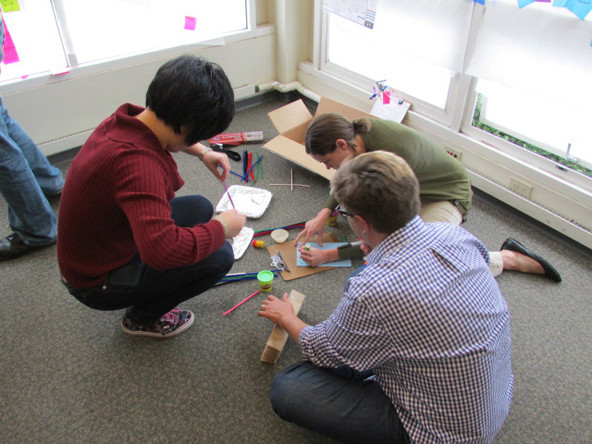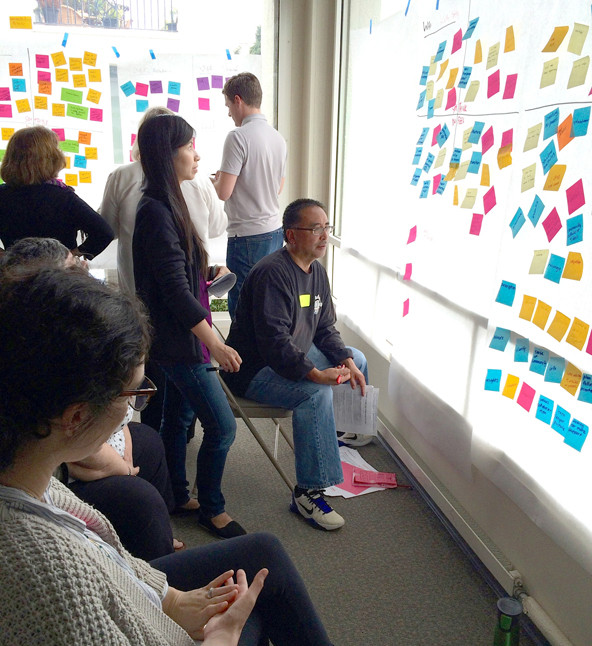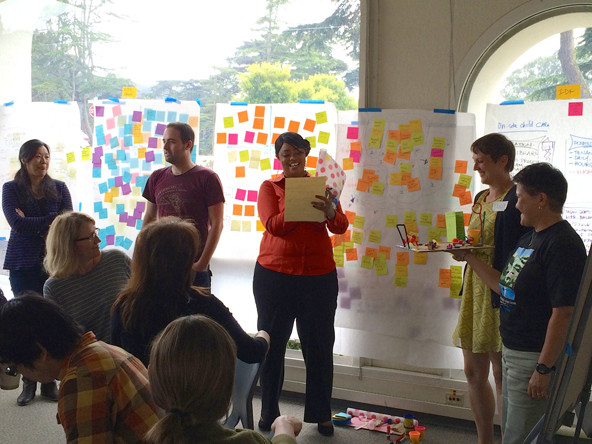In 2014, Tides hired its fourth CEO in four years. Founded in 1976, Tides’ legacy as a progressive provider of services and programming for philanthropists and nonprofits worldwide had fallen behind, and the organization had suffered years of financial losses.
Many members of Tides’ staff felt stuck in a hierarchy where they couldn’t ask questions or try new ideas. Staff members said they were “Band-Aiding problems and using duct tape solutions” to hold systems and processes together. For an organization whose mission was to advance environmental and social justice, these problems were counterproductive at best.
A few months into her new job, Tides’ new CEO, Kriss Deiglmeier, asked all staff members to attend a two-day training to build competency in using design thinking—a process that entails gaining empathy from end users to reframe problems, then prototyping and iterating creative solutions. The goal of the training was to expand staff skills, support collaboration across departments, and empower employees to identify solutions—in effect tilting the culture toward becoming more dynamic, nimble, and adaptive, and better equipped to deliver on Tides’ mission.
Some outcomes were unexpected, but the process proved a valuable tool in turning Tides around. Today, staff feel more confident with their new skills and report a new willingness to question old systems and approaches. In the past three years, Tides’ grantmaking has grown from $92 million to more than $250 million, and the organization has recorded financial surpluses and launched several initiatives with new partners.
Are you enjoying this article? Read more like this, plus SSIR's full archive of content, when you subscribe.
Doubling down on design thinking
In today’s rapidly changing nonprofit ecosystem, organizations are often compelled to chase new leadership development fads, but doing so often leads to ineffective, scattershot approaches that confuse staff, and waste precious time and resources. Standalone initiatives—such as personality assessments, reengineering, and management by consensus—are rarely up to the task of spurring deeper and ongoing changes, and traditional strategic planning processes rarely address underlying cultural change. Meanwhile, without concerted effort, neglect of organizational culture can lead to atrophy, and atrophy to stagnation. It’s imperative that organizations adopt an approach that aligns with their cultural priorities, commit to it, and then go deep.
Although not a panacea, design thinking can complement other work happening to transform an organization. In Tides’ case, this included setting a new vision, mission, and approach; updating the business model; organizational restructuring to put client delivery at the core; and investments in infrastructure coupled with people development to position the organization for the 21st century.
Tides brought in Stanford’s d.school instructors Nadia Roumani and David Janka to lead the trainings through hands-on, experiential learning exercises in small, interdisciplinary teams. The focus was on developing design thinking skills, rather than solving a particular problem at Tides. This distinction mattered because it provided space for open exploration, and didn’t infringe on any participant’s actual workflow or realm of responsibility. The time, energy, and resources invested in making sure trainings reached all staff members was a dramatic shift from Tides’ previous professional development approaches and uncommon in the nonprofit sector.
 Tides team members create prototypes—low-fidelity versions of their solutions. (Photo by Tides staff)
Tides team members create prototypes—low-fidelity versions of their solutions. (Photo by Tides staff)
Challenges and lessons
The trainings were a powerful spark that helped catalyze meaningful change at Tides, but no one approach is perfect. Not everyone brought equal enthusiasm to the design thinking training; some were even resistant. What’s more, between the first and last of the four design thinking trainings, and following an organizational restructure, Tides experienced significant staff turnover. Since then, as Tides has replaced staff and grown, educating new hires on the methodology has been difficult given finite time and resources.
Despite these challenges and limitations, a few factors helped drive positive results:
- Getting buy-in from senior leadership. The CEO, senior team, and board supported the process at Tides. Leaders were there to kick-off each training and personally endorse the methodology, and aimed to model openness to listening and experimentation moving forward.
- Dedication to the process. As a result of high turnover, the organization ended up investing in many people who weren’t there a year later. While this could be considered a waste, there was something instrumental about the decision to invest so significantly in staff during such a challenging time. According to Jonathan Mergy, Tides’ director of information technology, “It signaled that leadership wanted to invest in us. A lot of people were very hungry for that kind of education and empowerment. It was a signal that we were changing as an organization.”
- Allotting enough time. The two-day format made it possible to get beyond introductory concepts so that staff could dig into a concrete challenge and practice the methodology for themselves.
- Making it relevant. The activities used in the trainings were relevant to Tides’ staff, but not mission-critical or directly connected to anyone’s work, which enabled a climate of inquiry that didn’t feel too personal. The instructors also used case studies to illustrate how the new methodology applied to the work at Tides.
 Teams unpacked interviews, synthesized information, and selected a specific need to address. (Photo by Tides staff)
Teams unpacked interviews, synthesized information, and selected a specific need to address. (Photo by Tides staff)
New freedom to problem solve
Among Tides’ participants, the work on empathy, prototyping, and collaborative problem solving was particularly illuminating.
“The word empathy is ubiquitous and very easy to say, but really digging in and putting yourself in someone’s shoes, asking big, open-ended questions, and listening can be harder to do,” said Kim Sarnecki, Tides’ director of administration and real estate. “The design thinking approach helps us relate to each other.”
 Teams tested their prototypes and shared their findings. (Photo by Tides staff)
Teams tested their prototypes and shared their findings. (Photo by Tides staff)
Kathryn Snyder, Tides senior advisor, commented, “Developing a rough prototype and putting it out there for feedback, instead of waiting until you have the perfect thing, was a big takeaway. I learned it’s better to roll out something to try out, see what resonates, and after getting feedback from multiple diverse sources, put in more time for refinement.”
Snyder also commented on the way the design thinking training shifted her approach to collaboration. “Instead of working on something specific with the same people as usual, I now look to engage in radical collaboration with folks I might not normally work with, across different departments and different issue areas. Design thinking has encouraged me to step outside of my traditional working group and also influenced the way I look for connections across the work of our clients across sectors.”
Results
Shifts in the skills and culture at Tides surfaced throughout the organization. The facilities staff launched an innovative co-working space. Other staff members identified an opportunity to connect with colleagues around a shared love of music and started a Tides rock band. The finance team redesigned old forms and procedures in a more user-centered way. The IT group started asking more open-ended questions, discovering patterns in broken systems, and working to implement more comprehensive and user-friendly solutions.
Other changes were less visible. Staff reported a new sense of confidence in their problem-solving skills, more openness to suggesting out-of-the-box ideas, and more interest in seeking out new or opposing viewpoints. Some commented that the training facilitated a shift away from “us versus them” thinking—a recalibration that encouraged more autonomy, the use of new skills to fully listen to client needs, and a sense of shared ownership of Tides’ new vision, mission, and approach.
For some participants, the design thinking training eroded old taboos, granting permission to ask big questions and to look for broader connections between the many problems across the organization. The training illustrated to Tides’ staff that it wasn’t hard to bring a group together, ask questions, and try new things.
Investing in the whole rather than parts
With limited funding for nonprofit professional development, organizations are constrained in their capacity building efforts. Professional development investments tend to go to a limited number of employees, often with a focus on senior staff instead of the entire staff. But while such trainings can be instructive, participants often have a hard time bringing their colleagues along and putting their learning into practice when they return to the office. This approach also misses an opportunity to take an entire organization through a collective learning experience—a powerful way to build morale and create deeper relationships across teams.
Increasingly, organizations need to find ways to embed an agile and experimental mindset into their day-to-day work. Such cultural shifts toward rapid adaptation and experimentation do not happen by accident; change, especially cultural change, needs a catalyst.
Design thinking is particularly capable of sparking cultural change because of its methodology for collective problem-solving based on empathy, prototyping, and iteration. But for any change strategy to be effective, leaders and organizations need to dedicate ongoing time and effort, and funders need to support investments that foster staff innovation and experimentation. Building new skillsets is a strategic investment in both an organization and in the wider field of social good.
Support SSIR’s coverage of cross-sector solutions to global challenges.
Help us further the reach of innovative ideas. Donate today.
Read more stories by Kriss Deiglmeier, Nadia Roumani & Amanda Greco.

